Worms in the human body are not viable parasites on their own, they can only survive and multiply through the host (human or animal). Parasitic diseases are caused either by the worms themselves in humans or by their larvae. The disease spreads infectiously, and helminthic invasion often goes unnoticed, gradually causing disturbances in the body.
First, you need to understand what helmets are. It is a general term for worms parasitizing the human body, in the body of animals or even plants. This explanation is also the answer to the question of what worms are. The terms "worm" and "helminth" are synonymous.
The most dangerous helminthic invasion is the prolonged asymptomatic form that leads to diseases caused by nutritional deficiencies. Intestinal parasites live by absorbing nutrients from the human body. Helminthic invasion can be detected at an advanced stage, after the appearance of other symptoms suggestive of the presence of intestinal parasites.
The larvae of some intestinal parasites can reach different tissues in the body. In this case, inflammatory deposits are formed because the larvae are recognized by the immune system as a foreign organism. Certain allergic reactions of the immune system can occur as a result of helminths in humans.
When worms appear in humans, the symptoms and treatment of the invasion are closely related to the cause of the discomfort, i. e. the release of the parasite, and the signs of its presence also disappear.
Methods of infection with parasites
There are several factors in the appearance of worms. They can be caused by the following situations:
- one of the most common risk factors for helminthiasis is the impact of mass tourism;
- in second place is water and food pollution;
- helminths can become infected after consuming meat products and sausages;
- poorly washed fruits and vegetables are the main sources of parasitic larvae;
- the transmission of worms from pets is often recorded.
Symptoms of parasitic diseases
Infections of worms can manifest in different ways depending on the type of parasite. The most common manifestations are:

- constipation - difficulty in passing stools caused by worms - the result of blockage of bowel flow;
- diarrhea - loose stools appear due to exposure to substances secreted by parasites that cause potassium and chloride loss;
- bloating and bloating - parasites cause inflammation and gas formation in the small intestine;
- muscle and joint pain - helminthiases are often characterized by the location of worms, even in joint fluids and muscle tissue;
- allergy - parasites pierce the intestinal wall, causing undigested molecules to enter the bloodstream, causing an allergic reaction;
- skin problems - skin problems such as acne, rash and itching are common with helminthiasis;
- anemia - parasites adhere to the intestinal mucosa and "steal" nutrients, leading to anemia;
- granulomas - a tumor-like focus is formed that surrounds the eggs of parasites;
- nervousness - worms produce toxins that irritate the central nervous system, which can result in psychological signs;
- sleep disorders - nocturnal anxiety accompanies helminthic invasion for the following reasons: the worms leave the rectum, the liver becomes more active, trying to get rid of the toxins they produce;
- chronic fatigue is one of the first signs of parasites in the body;
- oncological diseases.

Pinworms
Pinworms are among the most common intestinal parasites in the human body. These worms are scientifically called Enterobiusvermicularis. They are spread all over the world. Although these worms are primarily characteristic of the child’s body and are most common in groups of children, they are also found in the adult population.
Infection occurs when the larvae of a parasite that are found anywhere in the environment of an infected person are swallowed. They are present on the skin, under the nails, in the bedding, in the clothes and in the dust. In the duodenum, the larvae develop into adult parasites and then migrate to the colon.
The adult dumplings are about 1 cm long, thin, reminiscent of white yarn. Eggs are placed in the perianal region. This is manifested in the most common symptoms of the disease - discomfort and itching in the rectum.
Complications of the infection caused by parasites are chronic intestinal inflammation in girls - secondary vaginal infection.
Two-thirds of those infected with intestinal parasites are unaware of the presence of helminthiasis because they often feel no symptoms other than anxiety, irritability, and fatigue.
Vlasoglav
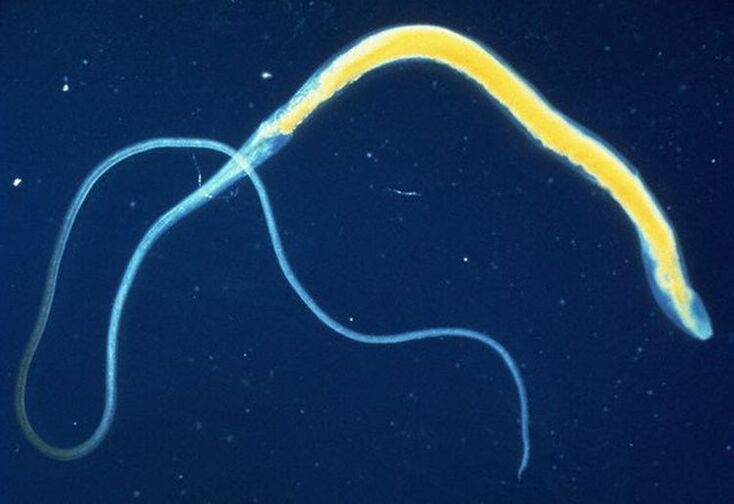
The second most common intestinal parasite is the whipworm, Trichuristrichiura. Infections caused by these types of worms are usually asymptomatic, making it very difficult to accurately identify the infected person.
The adult whipworm is 3-5 cm long. The parasite larvae hatch in the small intestine, while the adult worms nest in the colon. The adult female lays eggs that hatch with feces and hatch in warm soil after 5 weeks of nesting.
In the worst case, whipworm only causes abdominal pain, diarrhea, or nausea. More severe complications of the infection occur only in tropical areas. In severe cases, chronic diarrhea or anemia may occur.
Nematodes
Human nematodes contain two types of parasites: Ancylostomaduodenale and Necatoramericanus. Adult females are 10-13 mm (A. duodenale) or 9-11 mm (N. americanus), males 8-11 mm (A. duodenale) and 7-9 mm (N. americanus).
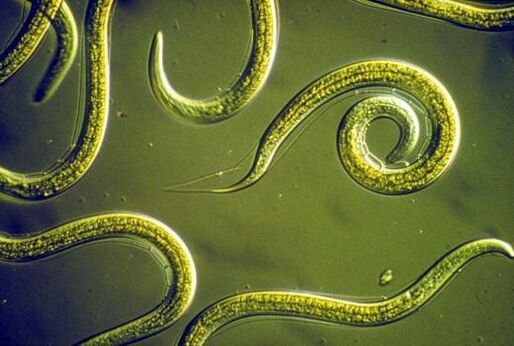
The eggs are excreted in the faeces from the host. Under favorable conditions (moisture, warm) the larvae hatch in the soil or faeces within 1-2 days, after 5-10 days they become larvae that spread the infection. They survive for 3-4 weeks under favorable natural conditions.
Contact with the human body occurs through the penetration of the parasite larvae through the skin. They enter the heart and lungs through the bloodstream, penetrate the pulmonary alveoli, and then enter the pharynx from the bronchial tree and are swallowed by man. The larvae reach the small intestine, where they remain for the time necessary for them to develop into an adult worm.
Adult worms live in the small intestine, adhering to the intestinal wall, feeding on the blood of their host, man. Most of these parasites are eliminated from the body within 1-2 years, but recording their ability to parasitize in the body can take up to tens of years.
The larvae of A. duodenale worms that penetrate human skin are inactive (either in the intestines or in the muscles). In addition, A. duodenale parasitic infection can be transmitted orally. However, the N. americanus worm requires migration.
Wormwood
Cylindrical worms - Ascarislumbricoides - are also among the intestinal parasites. An adult worm can grow up to 25 cm in length. In this type of person, helminths remain hidden for a long time. Their symptoms are most often fatigue and coughing, which in most cases can be attributed to other causes.
The use of unwashed vegetables and fruits is sufficient to infect helminthiasis.
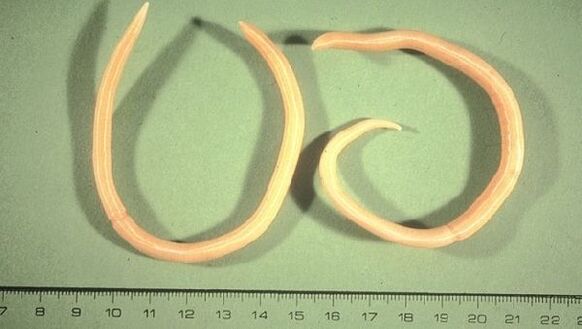
The larvae of these worms nest and hatch in the small intestine, penetrating the intestinal wall. They travel through the blood and lymph flow to the lungs, causing a cough. When coughing, greenish mucus is cleared, which, after ingestion, allows the intestinal worms to return to the intestines. Ascaris eggs are excreted in the faeces.
The most common source of human infection is infected human feces.
In severe cases, ascaris can cause inflammatory processes in the body, most commonly pneumonia. However, in most cases, those infected with the worms remain asymptomatic, or the symptoms are so mild that neither the patient nor the treating physician first suspects an infection caused by intestinal parasites.
The disease caused by ascaris is called ascariasis. The main mode of infection is oral stools.
The WHO estimates that the incidence of worms is about 1 billion people infected each year.
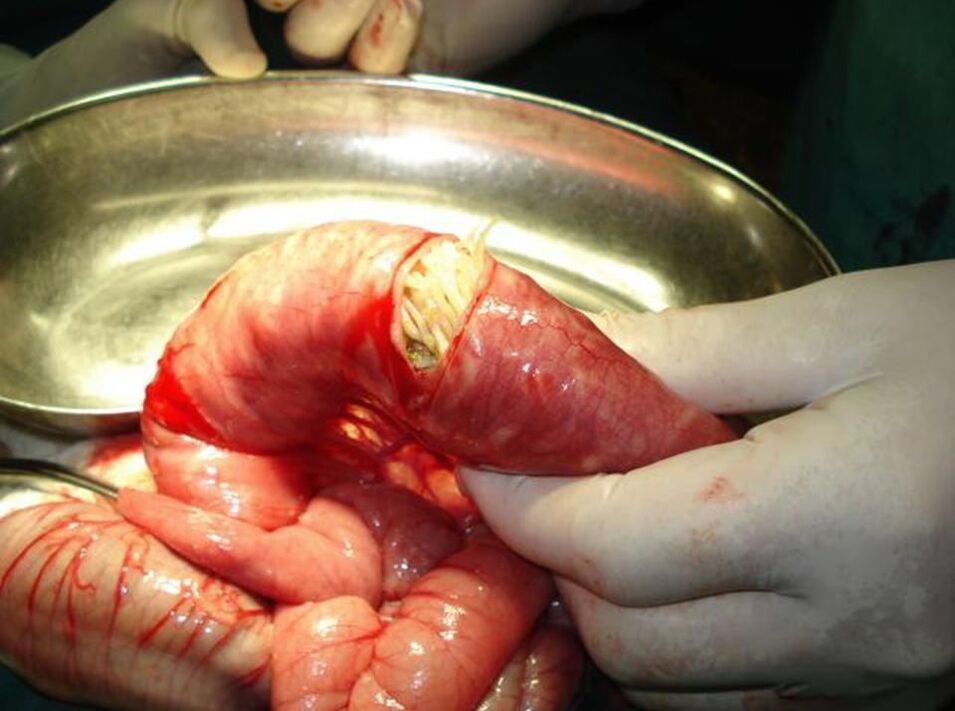
Adult helminths, the symptoms and treatment of which depend on the localization of the worms, are characterized by a number of clinical manifestations - from asymptomatic forms to severe or even fatal cases. Common symptoms include abdominal discomfort and pain, diarrhea, rectal itching, or allergic manifestations. In the first phase - migration - the larvae of the parasites can cause signs of inflammation in the lungs (Loeffler syndrome), pancreas, heart muscle, liver and other organs.
Spindleworms in the gut are the cause of metabolic disorders and nervous system disorders.
Ascaris in the respiratory tract
When worms migrate through the human body, they pass through the pharynx, where they settle in the lymph nodes around the main lymphatic chain (Waldeyer chain).
Where worm larvae may be present:
- lymph and salivary glands;
- garat;
- larynx;
- the area along the auditory canals leading to the middle ear;
- all the flights to the brain.
The lateral nasopharyngeal walls have openings that lead to the Eustachianus tube, which connects the pharynx to the middle ear. This allows the pressure in the ear to balance with atmospheric pressure. Along these pathways, worm larvae can reach the middle ear. This results in impaired hearing, tinnitus, headaches and Meniere's syndrome - dizziness accompanied by memory loss.
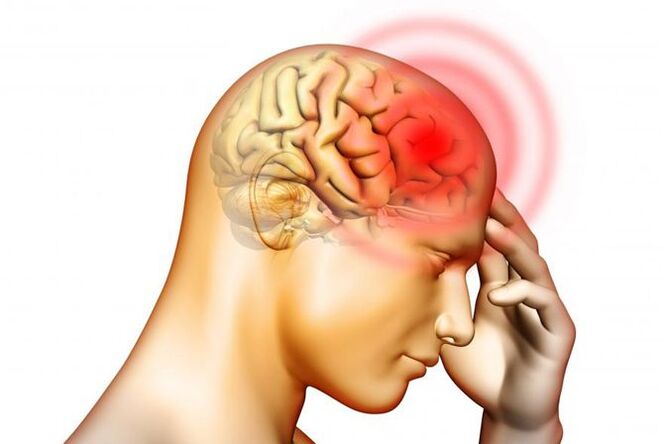
Manifestations of ascaris lung
In cases of ascaris lung disease, diseases of this organ and signs on the skin take the form of roughness and rash. These symptoms are accompanied by mild fever but sometimes febrile conditions. The person suffers from dry cough, asthmatic bronchitis and hoarseness. Without treatment, pulmonary ascaris can develop into chronic problems with seasonal flare-ups and eventually cause severe bronchial asthma. He or she becomes addicted to drugs and sometimes even retires on disability.
Roundworms in other organs
The larvae of the worms show minor bleeding and inflammatory signs due to the colonization of other organs.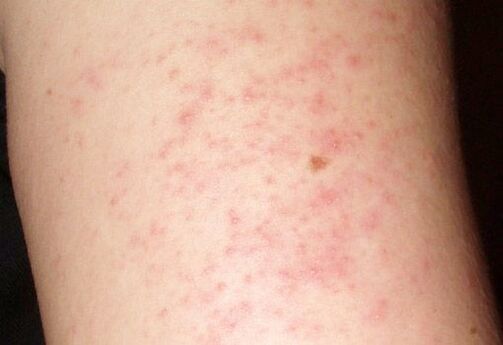 They are able to penetrate the pancreas, bile ducts and liver. In the small intestine, the larvae unite into a "lump", causing ileus. During human life, parasitic larvae live in the above-mentioned organs, feed on their metabolites and mechanically damage them.
They are able to penetrate the pancreas, bile ducts and liver. In the small intestine, the larvae unite into a "lump", causing ileus. During human life, parasitic larvae live in the above-mentioned organs, feed on their metabolites and mechanically damage them.
In the presence of larvae in the liver and bile ducts, the liver weakens and is unable to excrete toxins naturally. As a result, they are excreted through the skin, causing allergies, itchy rashes, swelling under the skin of "unknown" origin, and other manifestations in many variations, from dry eczema to purulent processes.
Ascaris in the brain
The symptoms of a brain invasion vary depending on where the worm larvae are located. If they are in the meninges, there is a risk of meningoencephalitis with migraine headaches. Upon colonization of the grooves, granulomas form in the gray cortex.
Symptoms of brain carcinoma appear later: loss of consciousness, seizures, convulsions. If the granuloma is located near the optic nerve or the auditory nerve, deafness or vision impairment occurs.
Tapeworm
The chain - Taeniasaginata, Taeniasolium - is one of the oldest and best known intestinal parasites. It can reach record lengths - up to 9 m.
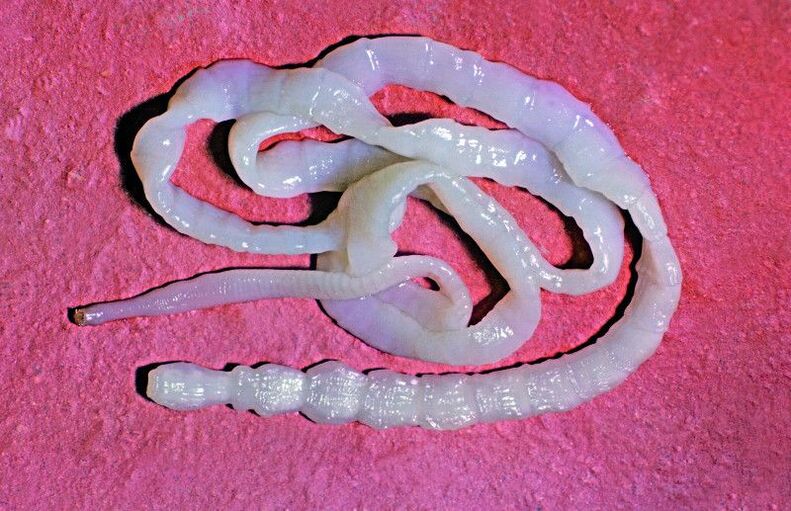
The two most common types of worms are bovine (Taeniasaginata) and porcine tapeworm (Taeniasolium). Both types colonize the body after consuming raw or improperly cooked meat. Parasitic eggs are long and are deposited in the small intestine. Adult worms develop after 3 months. The ends of the worm's body are filled with eggs, which are released one by one and excreted in the feces. The larvae are able to enter the bloodstream through the intestinal mucosa and then migrate to the muscles and brain, where they settle.
Despite the severity of the disease, tapeworm does not necessarily cause immediate symptoms in its presence and therefore remains invisible for a long time. The chain in the muscles causes muscle pain in the brain - epileptic seizures.
The parasite is detected by X-ray or computed tomography. An accurate diagnosis can only be made on the basis of these tests.
Parasite treatment
The methods for treating worms are varied. These include the popular use of antiparasitic herbs and state-of-the-art bioresonance therapy.
Antiparasitic herbs
The rules for the use of antiparasitic herbs are based on the localization of worms in the body.

It is advisable to take it half an hour before a meal in the following cases:
- parasites in the intestines and lower body;
- secondary infection with worms of the urogenital system.
Use with food: damage caused by parasites of the stomach, colon, liver and spleen.
Use after a meal: parasitic infection of the upper body, lungs, neck, head.
Recommendations for the use of antiparasitic herbs:
- not recommended for pregnant women;
- one of the most common herbicides, wormwood, should not be used for stomach ulcers.
Chemical antiparasitic agents
Drugs containing carbamic acid methyl ester are the most effective. This active ingredient is used to treat fungal worms, whipworms, tapeworms and tapeworms. When handling pinworms, dosing should be performed according to the instructions. Treat other parasites with these medications according to age.
Adherence to dosing is important to avoid convulsions.

Treatment using therapeutic frequencies on a bioresonance device and using a plasma generator
These devices destroy pathogens in the body without negative side effects. When using a bioresonance device, electrical impulses pass through the tissues, when using a plasma generator - radio waves that cause the parasite membrane to vibrate. The result is rupture of the membranes and consequent destruction of the parasites. A specified frequency is used for each type of microorganism.
It is very important to follow the system measures when treating worms: to exclude alcohol consumption and subsequent detoxification. Dead worms must be removed from the body, otherwise they will be encapsulated and act as allergens.
All parasites present are removed by treatment with these methods. The therapy takes place in 2 stages:
- Stage 1: removal of small parasites - 20 minutes for each microorganism;
- Stage 2 - removal of large worms - the frequency is used first to kill eggs, then larvae and finally adult worms.
Optimal timing of therapy:
- Unicellular: 5 minutes per plasma frequency; bioresonance - 20 minutes per frequency.
- Multicellular: 10 minutes per plasma frequency; bioresonance - 4 × 20 minutes at 1 frequency.
In addition to the significant reduction in processing time, the use of a plasma generator has the great advantage of using up to 5 people with animals. Operating range up to 5 m.
Conclusion
The treatment of worms involves the removal of sugar, sweet baked goods and potatoes - these foods create an ideal environment for the survival of helminths.
When treating the child, it is recommended to give him roasted pumpkin seeds to chew - approx. 30 seeds 3 times a day. You should not eat with the main course.
Moderate consumption of raw garlic will also help eradicate worms.
Getting rid of worms will not work without proper hygiene. Washing hands, frequent bed linen and washing dishes are the basis of effective therapy.





























